Dr. Stuart Dawson, May 1st 2024
This is a simplified blog version of Stuart Dawson’s research paper ‘Ned Kelly’s Avenel School Days’ that can be downloaded at the bottom of the page. It shows that a lot of what has been written about the Kelly children attending school at Avenel is incorrect. Assuming that the evidence presented in the paper is accepted there will be some important changes needed to the current Kelly narrative, including on several government websites and the Ned Kelly Touring Route.
——
It has long been held that Ned Kelly and his sisters Annie and Margaret attended Avenel Common School once the family moved from Beveridge to Avenel in January 1864. Yet the Kelly children never attended Avenel Common School. Rather, they attended Avenel’s first small timber school at least half a kilometre from the town block on which Avenel Common School was built later.
Three successive schools at Avenel
Amelia Burgoyne (Memories of Avenel, 1955) wrote, “The first school in Avenel was built of bark, on the hill close to the bridge, in l856. It was an ‘undenominational’ school established by the Church of England. The first teacher was Mr Richardson, and so it was known as ‘Richardson’s School.’ He was succeeded by Mr Irvine. Among the pupils were … Annie, Maggie and Edward Kelly”. This will prove to be more or less correct: two Kelly children attended the original Richardson school.
Confusion has resulted from Burgoyne’s subsequent statement that, “About 1863, a Common School was built at Avenel, made of slabs, as a successor to Richardson’s·bark-walled school.” As the Kellys arrived in Avenel from Beveridge in January 1864, it has been incorrectly surmised by most commentary that the Kelly children attended the Avenel Common School. Yet as will be seen from this account of the successive schools and locations, the latter had not yet been built.
‘Richardson’s School’ (1856)
The first school in Avenel was established by the Church of England in May 1856 in a small bark hut located on the hill close to the stone bridge. The building measured 26 x 15 x 9 feet (roughly 8 x 4.5 x 2.75 metres, or the floor area of a large 6 x 6 metre double carport). It had slab sides, a bark roof, a boarded floor, and was lined with calico. Richardson taught at the school until 1861, and in the following year (1862) it became a Common School (at least, on paper). Despite confusion about when the subsequent Common School was built, there was only one school in Avenel that school inspector G.W. Brown visited each year from 1863 through 1866, and it was the old bark Richardson school in which Irving taught throughout those four years as discussed below.
Brown visited the school on 30 September 1863. He listed it as ‘Avenel C.E. School’ and noted “an old timetable (3 years old) is posted up; Irving rather harsh in manner; boxes and pulls ears; carries a tawse”. This is the earliest surviving school inspection notebook in the PROV that lists the Avenel school. It confirms that it was the same Church of England Richardson’s school that, from the old timetable on the wall, was running in 1860, with teacher James Irving now in charge in late 1863.
Brown returned on 30 March 1864 and inspected what he listed as ‘Avenel School’, the change of name likely following on from the abolition of Denominational school boards. He noted amongst other things, “Buildings: Sides slabs, lined with calico; roof bark; floor wood. 26 x 15 x 9 feet. Repair: Roof in very bad order; a new one required. Out-offices [toilet]: Only one; in bad order. Playground: Reserve all round, no fence. Teachers: James Irving; Henrietta Irving. Rules: Building used for service” [=church on Sundays].
Most importantly for this analysis he recorded, “Special: ‘Common School’ is not up.” It is clear from this that the deteriorating school building in which Margaret and Edward Kelly were tested in March 1864 was the same of ex-Church of England school that Brown had visited the previous year, with the Common School not yet built. Brown’s comment further implies that a Common School was intended to have been constructed on a different site as would happen.
Brown inspected it again on 15 September 1864, listing it as ‘Avenel School No. 8’. On 30 March 1865 he inspected again; Margaret and Edward Kelly were present and tested. The same building as in the March report is described. By 18 October 1865 no Kellys were on the roll; Edward and Margaret had ceased to attend at some point before then.
Brown’s next visit on 17 April 1866 recorded the same building and dimensions and that “Slabs require fixing; lining repairing”. On 19 September 1866 along with the test results there is a semi-legible note about “Repairs effected” at the bottom of the page. The ‘repairs’ are to an existing building; it is inconceivable that he would not have recorded if this visit was to a newly built school room. In sum, the same aging Richardson’s school building dating from 1856 is described from 1863 through to 1866.
Further confirmation that this school was in a different location to the subsequent Avenel Common School is found in a death notice in the Age, 10 September 1926. It states of Mr William Tebble that “in his youth he went to school with Ned Kelly in the old common school, near Hughes Creek, Old Avenel”. Corroborating this, Tebble is listed with Edward Kelly among the Grade 3’s in Brown’s 30 March 1864 ‘Avenel School’ report. This suggests a clear distinction between the Richardson school as the “old common school near Hughes Creek” and the later Avenel Common School built on land purchased by Richardson in 1861 and/or 1862 east of Shelton Street and away from the creek.
It is not possible from Brown’s few surviving notebooks to determine when the Avenel Common School on the west side of Livingstone Street was opened, but the fact that Avenel’s only school is listed as ‘Avenel No. 8’ in both his 19 September 1866 and 2 June 1868 inspection reports suggests that the name was simply carried over to the new location without elaboration.
Ned’s oldest sister Annie did not attend Avenel School
Annie Kelly, born 15 November 1853, was 10 when the Kellys moved from Beveridge (where Ian Jones wrote that together with Ned and Maggie she had attended Beveridge’s Catholic school for 6 months from July to December), to Avenel in January 1864. John McQuilton wrote that at Beveridge Red Kelly worked as a bush carpenter and horse dealer in between trips to the goldfields, and Ian MacFarlane noted that it was Red Kelly’s alcoholism that had forced the family to sell up.
Nothing records Annie being at Avenel School and, as Education Department historian L.J Blake noted, Mrs Kelly then had 3 children below school age: Jim aged 4½ (born 31 July 1859); Dan aged 2½ (born 1 May 1861); and Kate 6 months (born 12 July 1863). It is obvious that, in addition to the additional weekly school fee that would have been required, Annie stayed home to help her mum and dad with her siblings on their newly rented 40 acre farm. It is an idle fancy of Kelly enthusiasts to imagine that Annie attended Avenel school in an attempt to improve her prospects.
Avenel Common School
A steadily growing population in Avenel led to the construction of a new timber slab school building on land owned by Richardson in Livingstone Street. A Strathbogie Shire Heritage Study accepted a date of “in (about) 1863” for the erection of this building clearly based on Burgoyne’s statement that it was built “about 1863”, but this in turn seems to be based only on the passing of the Common School Bill in 1862. It is not clear when the Common School was built, but as the school inspection reports 1863 to 1866 analysed above relate to Richardson’s old school, Avenel Common School did not commence operation until at least 1867.
A sketch of the Common School building from 17 September 1874 (in McMenomy’s Ned Kelly: The Authentic Illustrated History), about the time it ceased to be used as a school, shows that it was 40 x 12 x 10 feet high (12 x by 3.65 x 3 metres), of which the classroom area was 26 x 12 x 10 feet (8 x 3.65 metres) and was said to have a wooden floor and canvas-lined walls. This is the school wrongly claimed for the Kelly children by a Ned Kelly Touring Route sign.
Avenel State School (1874)
This was Avenel’s third successive school. It was located on a five acre allotment on the east side of Livingstone Street opposite Avenel Common School, and it has grown with building additions over time into the current Avenel Primary School.
Conclusion
Avenel School No. 8 up to and including 1866 was a only name variation of the original Richardson’s school near Hughes Creek, erected by the Church of England in 1856 and suffering deterioration of its slabs, bark roof and calico lining during the years 1864 and 1865 when Edward and Margaret Kelly – but not Annie – attended. Avenel Common School was built much later in a different location and opened in or after 1867 on a town block roughly opposite the current Avenel Primary School. This in turn partly dates back to 1874. Neither of these latter schools had any connection with the Kellys.
TO DOWNLOAD THE FULL VERSION OF THIS POST with REFERENCES CLICK HERE: Avenel – Dawson Revised Final 2 and for the APPENDICES CLICK HERE: Avenel Revised Final Appendix Optimised
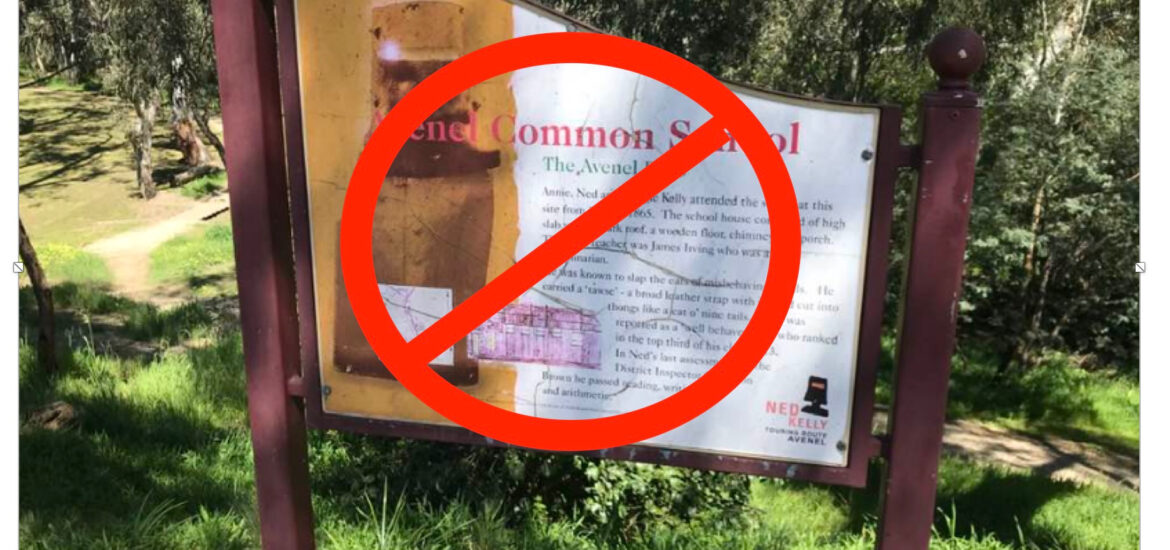
It has always be known the school site where Ned and Margaret attend. The site has been marked.
Attachment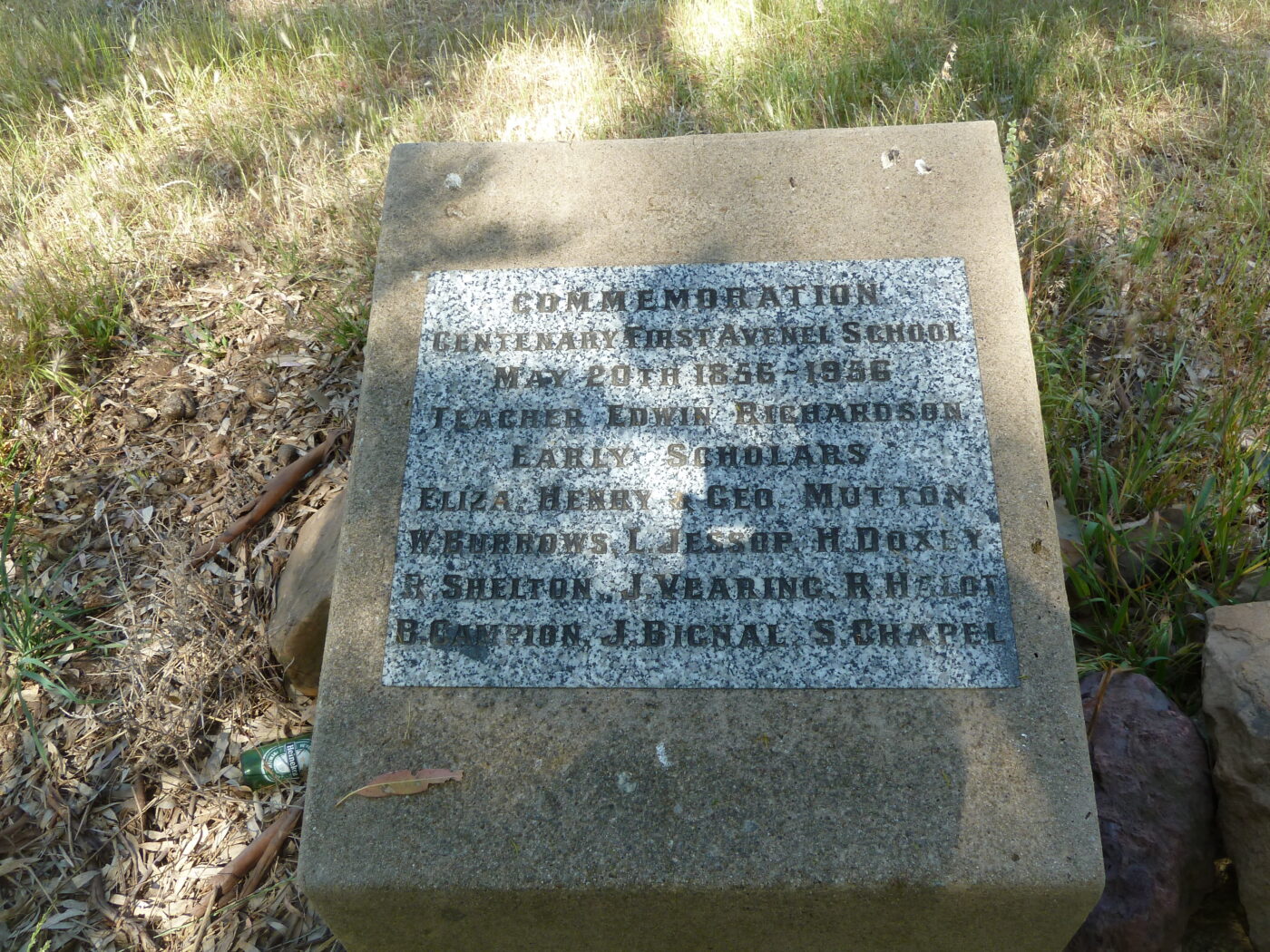
Hi Anonymous, that’s great, but where exactly is this marker located?
Henry and Livingstone. Now on private property
Attachment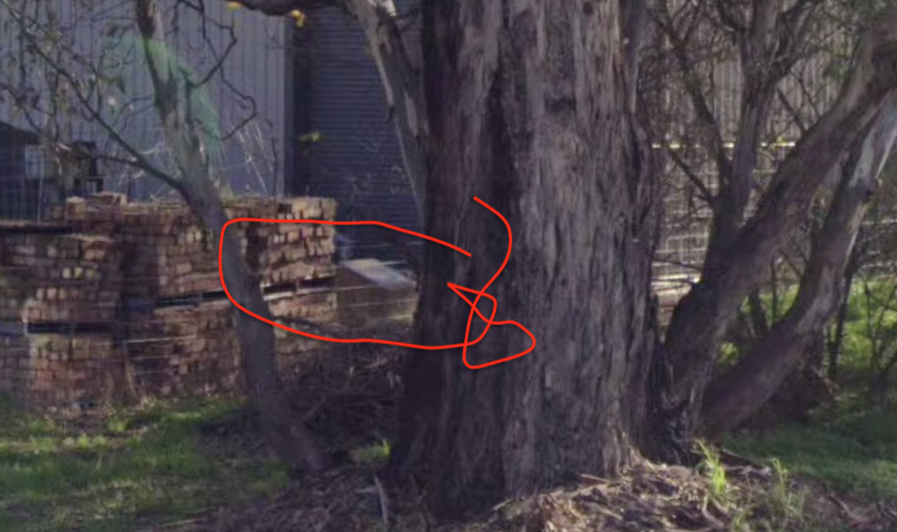
Hi Anonymous, that’s fantastic. Half an hour on Google maps then Google earth further locates the First Avenel School marker to be roughly opposite 83 Livingstone Street, south of Henry Street and near the Hughes Creek bridge.
So the first 1856 school was nowhere near the Avenel Common School which was north of Watson Street between Shelton and Livingston Streets, or the later Avenel State School north of Watson Street between Livingston and Anderson Streets.
Attachment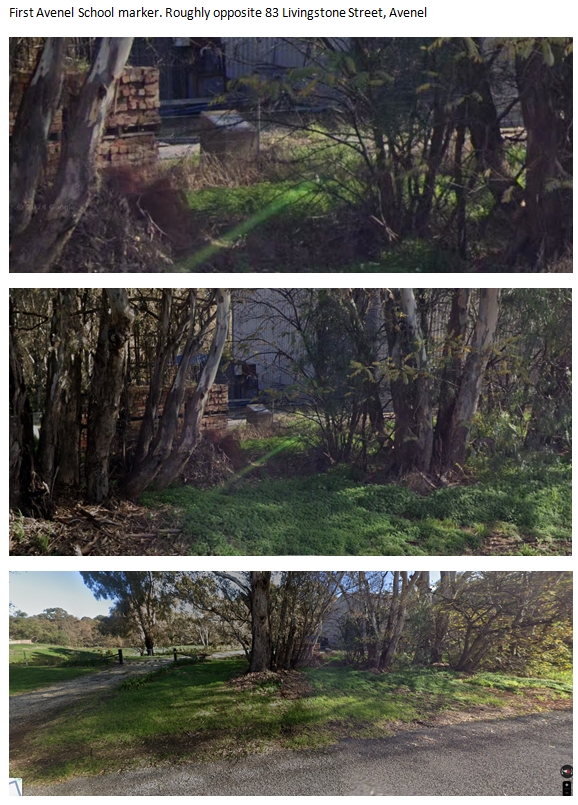
That Marker indicates where the first school was but it doesnt record any of the Kellys as being “Early Scholars” but it DOES record R Shelton!
Is public access permitted by the private owners?
David those that commissioned the marker omitted the Kelly children. The marker can been seen by the road side.
We can further see that Richard Shelton had a roughly 5 minute walk to school from the Royal Mail Hotel at 26 Henry Street and over the Hughes Creek bridge. Google maps says 6 minutes but Richard would not have stuck to the road as the Google walking map blue dots indicate, but gone through the bush to the school which as the school inspector’s reports state was unfenced in a reserve.
Attachment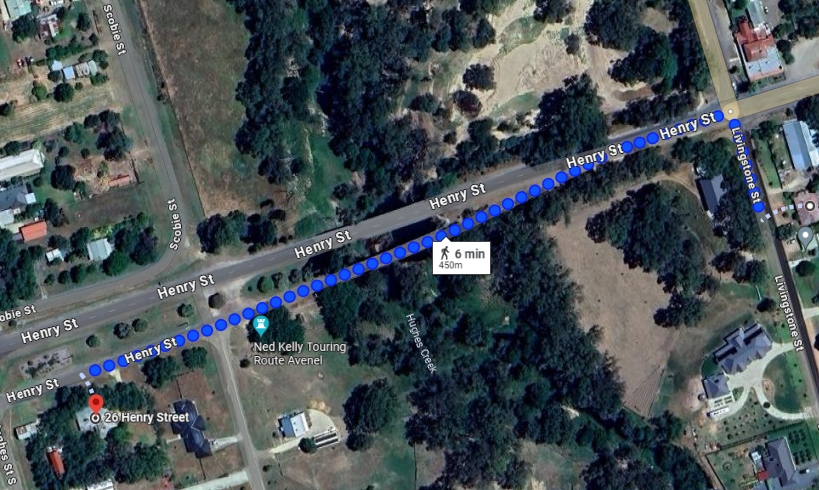
Stuart, once young dick crossed the stone bridge he would have cut across the fields. Making the journey less in time
Attachment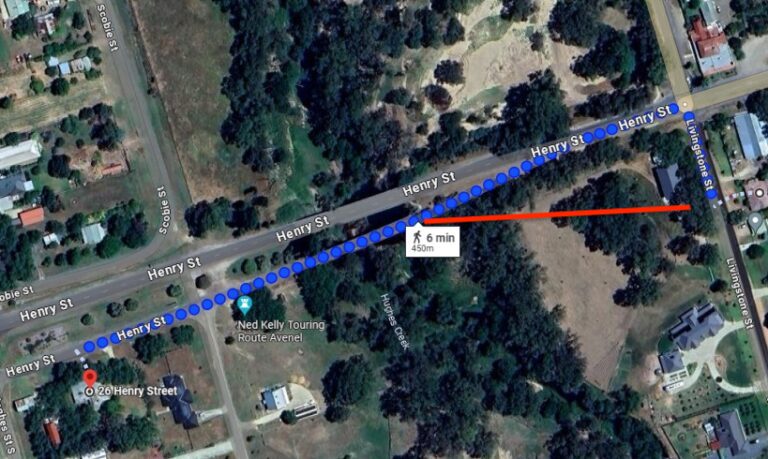
Hi Anonymous, that’s what I was trying to say in words; loving the red line to illustrate it.
Stuart I feel terrible forgive me. I should have first read then reply
Hi Anonymous, no worries at all; I never thought of drawing a line so that’s great you did it. Obviously I’m going to have to rewrite some of my report and delete all the bits about trying to work out where the first school was, and delete the two map appendices that were part of trying to work the location out. Would you be OK with me using a copy of your first photo showing a close up of the First School marker text in the revamp? If not I can go and take my own pic when I go up the Hume past Avenel. I won’t be put out if you say no, but worth asking.
I was going to mention revising the report to better reflect. Feel free to use the image as you see fit.
Hi Anonymous, many thanks, I will do so promptly!
This is great that Anonymous 101 has produced the Frst Avenel School marker to prove the location of the 1856 school. The location is important because as we can see from the Ned Kelly Touring Route Avenel Common School sign, discussed in my downloadable article, it marks the location of the Common School west of Livingstone Street and north of Watson Street that the Kelly children never attended. They weto the old school south of Henry Street which I have not found in any of the commentary. If it has been noted in any Kelly books, I’ll be surprised because I searched all the standard ones.
Grantlee Keiza, ‘Mrs Kelly’, for example says p. 56, “So Annie, Ned and Maggie continue their education at Avenel’s common school, which has replaced a Church of England academy in the same slab-and-paling building.”
Now we can see that this is not correct. First, Annie never went to school in Avenel (unless someone can whip up evidence that someone remembered going to school with her, but I searched without success for anything about that), and second, the old C of E Richardson’s school was some 650 metres away down Livingstone Street, south of the later Common School location.
Further to that and to clarify, the March 1864 school inspector’s report said that the “Common School is not up”. The old Richardson school south of Henry Street is where Ned and Maggie went in 1864 and maybe half of 1865.
Nice work Stuart
Thanks Thomas, it’s a bit of an obscure thing to take an interest in but going into PROV and reading the old school inspector’s notebooks was pretty amazing. I can’t imagine going around Victoria to every school twice a year and doing tests and a report of the sort GW Brown did back then. Of course there were not so many schools but it must have taken a lot of dedication to keep up the pace for several years every year. Plus he did separate reports on the school teachers in a different set of notebooks but I didn’t bother checking through them as I was only looking for Avenel for the Kelly kids. Walking around the old Hughes Creek bridge is great if you haven’t done it, such brilliant architecture back then with top class workmanship and character.
I concure
Dept of Education.
Attachment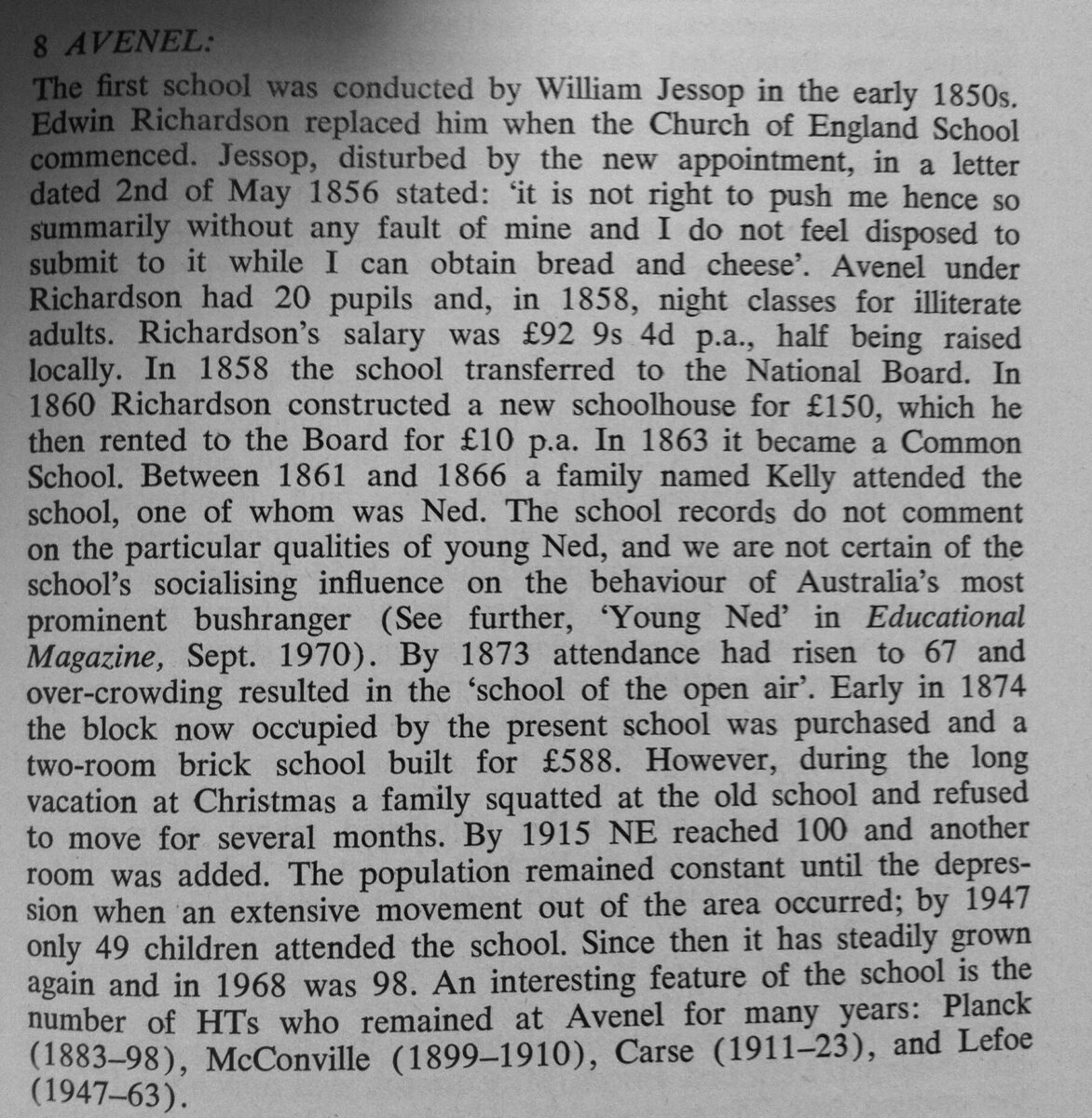
Hi Anonymous, more interesting stuff. I’m guessing this is from Les Blake’s history of education as it references his 1970 Young Ned article and has the same incorrect dating of the Kellys moving to Avenel in 1860 and attending school 1861-1866.
There is still a question of when the earliest school commenced. It is clear that the Church of England school known as Richardson’s school in Burgoyne’s ‘Memories of Avenel’ commenced in 1856, and thanks to the place marker you brought to light we know where it was. Blake says in the Avenel extract that the first school was in the early 1850s and was run by Jessop. Jessop complains on 2 May 1856 that he was summarily dismissed. Could the summary dismissal refer to commencement then dismissal both in early 1856?
Nothing elsewhere mentions any form of school in Avenel before the school known as Richardson’s school. Everything elsewhere says that Richardson’s bark hut school was erected by the Church of England in 1856. We known the dimensions of the Church of England school from the March 1864 inspection report and we know from the only surviving 1863 inspection report that it was the same building with an old 1860 timetable on the wall.
We know that it was in disrepair in 1864 needing a new roof, and that it continued to need more repairs through into 1866. We also know the dimensions of the school known as Avenel Common School published in McMenomy and that it was a different and larger building to the one known as Richardson’s school. We know that in March 1864 that the Common School “was not up”. We also know that the school known as the Common School was over half a kilometre north of the 1856 school. We know that Richardson bought the two blocks where the Common School was built only in 1861/62 and that it was not yet up in 1864; and that the dimensions of the old school remained the same from at least 1864 through 1866 and by deduction from the school reports at least back to 1860.
Blake says that Richardson built a new building in 1860. Why would he do that when he purchased land half a kilometre further up Livingstone Street in 1861 on which an Avenel Common School was subsequently built?
The only way all of this makes sense is either that Avenel had four schools, a previously unknown Jessop school prior to the 1856 school erected by the Church of England that became known as Richardson’s school, that the Strathbogie Shire Heritage Study and every other Avenel historian was totally unaware of; or that Jessop’s summary dismissal was shortly after the 1856 school opened. The latter is the logical conclusion.
We know that Blake has his dates wildly wrong for his statements about when the Kellys moved to Avenel and when they attended school. We can see that he places them in a new school but we know from the school inspection reports that the building they attended was in disrepair with only one toilet for both teachers and students until a new pair of toilets were built for the old school in 1866. The old school had a nine foot ceiling but the Common School had a ten foot ceiling as required to get government co-construction funding from 1864.
It seems inescapable that Blake has got his dates wrong for Richardson building a new school, dating it to 1860 before Richardson had bought his town blocks in 1861/2 where the first Common School was erected; the one that served Avenel until 1874. What do you reckon?
Vision & Realisation
Most good libraries hold the two (or three) vol edition. Published early 1970’s. I’ll get back to you
It was Vision and Realisation – a centenary history of state education in Victoria Vol 3. Oddly enough, I had found that under google books during Stuart’s research phase BUT it was not full text. We could only seem very slim snippets from it when searching for Kelly, Shelton, etc. Then, after it would show you 3 or snippets it would not show you the rest of them. Thing is, how did Blake find this info and no one else ever did? Under one database there is no listing at all for William Jessop Avenel. Need to check others. How can we be sure the stone is in the right place? Question everything! lol At least Stuart can revise his article with this new info, imagine if it was a book gone to print! Even when folks revise books there are those who only have the first one and don’t know it has been fixed. Have witnessed that here with the McM book and others!
Hi Sharon, Blake was apparently the official Education Department historian but that doesn’t mean he got every fact right. No one does! He would have accessed departmental files, such knowing what Richardson got paid. He knew when the Common Schools act came in but the Avenel inspectors reports show it was still called the CofE school the next year (1863) and the Common School was reported still not up in 1864. A bit more looking needed maybe. I’ll see if I can easily find the Vision book 📖📖
Too right that everyone makes mistakes! We are not immune and neither are anyone else. Regarding the book, no need to go out of your way for it as anon 101 had the pertinent page in their comments. Just rechecking google books and using the search term shows this showing it is the same page-
Vision and Realisation: A Centenary History of State …
books.google.com › books
Leslie James Blake · 1973 · Snippet view
FOUND INSIDE – PAGE 635
A Centenary History of State Education in Victoria Leslie James Blake. PRIMARY SCHOOLS 8 AVENEL : The first school was conducted by William Jessop in the early 1850s . Edwin Richardson replaced him when the Church of England School …
Thanks Sharon, excellent!
We can maybe get some recent clarification from the Strathbogie Shire Heritage Study Stage 2 ,Vol 3, p.2: “[Richardson] taught at the school until 1861, and in the following year it became a Common School. A steadily growing population in Avenel led to the construction of a new timber slab building for about £150 in (about) 1863 on land owned by [Richardson] in Livingstone Street, who leased the building to the Education Board for £10/year. A drawing of this building in 1874 (about the time it ceased to be used as a school) indicates that it was 12 metres by 4.3 metres, and was said to have a wooden floor and canvas-lined walls. … In 1863, Richardson sold the site to James Jamieson Irving, who was the next teacher at the school. Irving retained it until 1869 when he sold it to Robert Campion.”
From this it seems that Blake’s dates are again incorrect. Blake has the new schoolhouse being built in 1860 which he rented to the School Board, with it becoming a Common Schooll in 1863. He then has it in use until 1874 when the State School was built and opened.
The Strathbogie Heritage Study has the new school house being built “in (about) 1863” an approximate dating taken straight from Burgoyne. Most importantly it has the new school room built on land owned by Richardson in Livingstone Street, which is the land he bought in 1861/2.
The Strathbogie Study has Richardson selling the old site to teacher Irving who kept it until 1869 when he sold it on. What was Irving doing buying an old school building in 1863 if Richardson has built a new Avenel school by then? The answer is that he was teaching in the old original building until the Common School was set up on Richardson’s town block. We know that from the school inspector’s reports giving the dimensions of the old building in 1864-1866.
Irving was busy teaching in the old building until at least the end of 1866; there was no point at which Avenel had two schools running, and in 1868 the inspector’s report (only available for the second half of the year) continues the name Avenel School No. 8.
At this point we can disregard Blake’s horribly confused dating and run with the Strathbogie Heritage Study based on land transfer documents.
We can probably conclude this part of the topic at this point. In summary as it looks now, Richardson’s bark hut school was erected by the Church of England in 1856, with some guy Jessop initially appointed as teacher and summarily dismissed in March 1856 to be replaced by Richardson. Richardson bought a couple of blocks of land further up Livinsgstone Street in 1861/2 and taught there likely until the end of 1862 until Irving became teacher in 1863. Richardson sought to put a new school up but it was not up in 1864 and it is uncertain when it was built. We don’t know what was going on at Richardson’s town block but Irving taught the Kelly kids in 1864 and 1865, and was still there as a teacher in 1866. This means that Richardson’s new Common School was not up and running before 1867. At some point between 1867 and 1868 the newly built Common School took over as Avenel’s school and Irving sold the original bark hut school site where ha had taught for several years to Campion.
Can anyone see any problems with the summary? Or add anything further?
Just for interest, a rare photo of a bark hut school, the only one I could find online yesterday. Charlton 1875. This is from the Charlton Goldern Grains Museum Inc, Victorian Collections Identifier P3505. For the description click https://victoriancollections.net.au/items/5ab5ad3f21ea670eb42e51cd
Attachment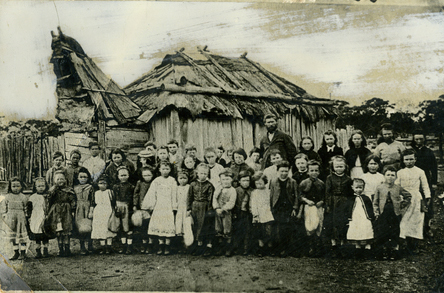
Possible routes taken by the kelly children
Attachment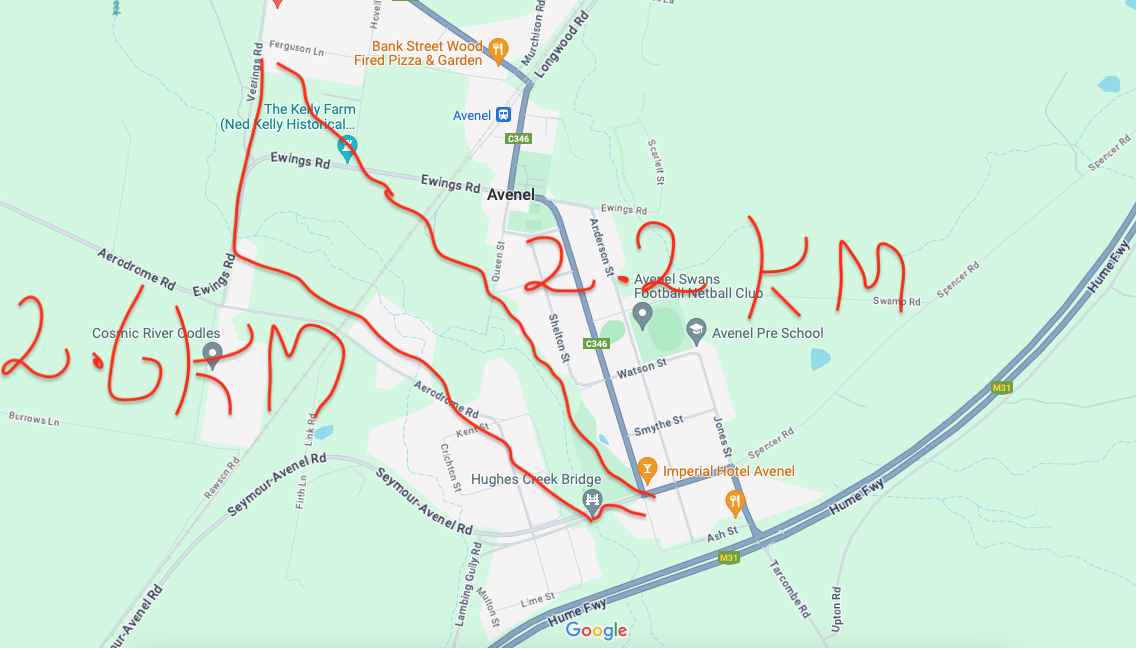
I have it on good authority that there’s an oral history from the old people of Avenel that young Ned used to walk 7 minutes every lunchtime, in rain, hail, or shine from the Richardson School to the Avenel Roadhouse for a steak sandwich with the lot (with extra beetroot). Funny kid.
It’s a nice day to go to the pub,
It’s a nice day to eat some beetroot
Cosmic Psychos
Nice day to have some sauce
Have some sauce
Have some sauce
Saw them live at a festival a few years ago. Was a great show.
The rubbedy dub, rubbedy dub! I won’t say how many years ago I first saw them…
Hi all, I have done a revised final version of the Avenel School Days article for upload today assuming David is available to do it and there are no technical upload issues. It removes all the discussion about where the Richardson school may have been located, and the two Avenel maps in the appendices, and replaces that discussion with the proof of the first school’s location kindly provided by Anonymous 101. This is a great improvement to the article.
Hi all, the revised final version of the full Avenel School Days article is now on the blog at the end of the blog summary version. The appendix which has photos of all the School Inspector’s reports about the Avenel school in the PROV is also there as a separate download as WordPress couldn’t handle the file size as a single combined document.
I wanted to make all the school reports accessible as reasonable quality photos for anyone who wants to check and confirm the points made in my article. There is no point making claims that force a change in accepted narratives unless the evidence can be verified.
In case anyone is wondering what school inspectors inspected in 1860s Victoria, and what students were supposed to be learning about, here is an inspection list and programme that was pasted into the front of one off GW Brown’s school inspection notebooks.
We can see what Ned, in the third grade in 1864 and in the fourth grade in March 1865, was supposed to be learning and passing. He presumably passed third grade by the end of 1864 in order to be promoted to fourth grade in 1865.
Poor Maggie Kelly didn’t satisfactorily complete second grade in 1864 and was repeating second grade in 1865.
For the evidence, download the Avenel Revised Final Appendix at the bottom of this blog article.
Attachment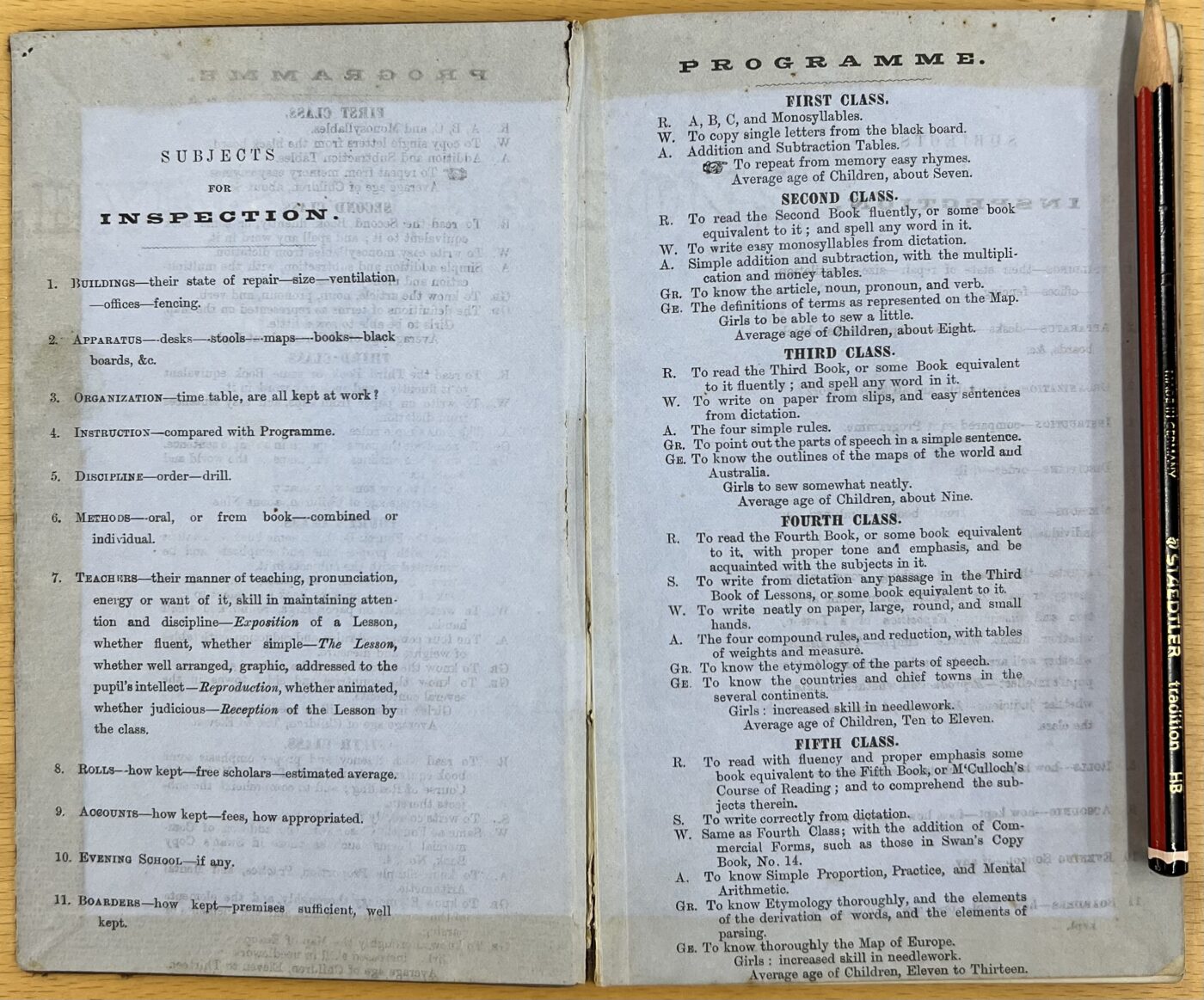
Anyone interested in the topic of Ned Kelly’s Avenel school days might like to know that the previous ‘Revised Final’ version of my Avenel article has been replaced with a corrected ‘Revised Final 2’ version on the download link. What has changed is that on p. 6, I had written ‘March 1864’ for one of Brown’s Avenel school inspection reports, instead of ‘September 1863’, for the report where he refers to the school as ‘Avenel C.E. School’.
I have fixed this in the ‘Revised Final 2’. I have also added two links to the blog on page 7, one for the Appendix and one for anyone wishing to cite the article, to give its its online URL location. I think that’s it for this topic. Another correction to the historical record.
Excellent work, as always, Stuart. As I always say, be glad it was an online article so that it could be easily amended versus a print book. One thing that got me wondering about the criteria for school inspections was the inclusion of sewing and needlework for the girls. I know we had Home Economics back in school, but in those days wouldn’t the girls have learned that necessary skill at home at their mother’s knee? And what about the boys, the ones who would be bachelors or on remote stations shearing or out gold mining or whatever, wouldn’t they need to know how to mend their clothing when in a place with few or no women to do it for them?
Hi Sharon, thanks for the feedback! I think needlework was taught in school to try and encourage neatness as opposed to just mending or basic darning, but I haven’t looked into it; I just know it was common (as the curriculum outline shows) and also done at home. My wife used to have a book called The Subversive Stitch that she says was about sewing and children as young as nine doing samplers. I’ve seen a few alphabet letter samplers pictured in Victorian era books, and we have one on the wall here that’s a 1980s reproduction one that someone did when there was apparently a Victoriana revival.
I reckon the single blokes would have just made do and looked shabby, before the days of cheap chain store clothing from overseas that’s killed most of our clothing manufacturers. And as you know hand me downs were the thing for boys and girls in poorer families. We know Dan Kelly got around in oversized raggedy second hand clothes looking like a misfit. Maybe he was the inspiration for punk!
On the long-running discussion of Ned Kelly’s age, one point in the discussion being the entry in the Avenel school inspection reports, another interesting thing is the entry in the Victoria Police Gazette of 6 November 1878 (No. 45, p. 303) after the Stringybark Creek murders:
“Amended description of offenders:-
First, Edward Kelly, 23 years of age, looks older, …”
November 1878 minus 23 years dates his birth to mid 1855. Just saying…
Just some feedback on the Avenel article and appendix – I sent it by email with the appendix photos weblink to a number of people and places, including several museums and shire councils on the Ned Kelly Touring Route. It was well received by half a dozen or so people who know what they’re talking about, and acknowledged by 7 or 8 agencies and mueums.
Now it is in the wait and see basket as to whether the various instititutions and agencies follow on with the suggested corrective actions in the report. I imagine it will take the various places time to review it and decide what if any changes they wish to make to the information they put out about the Avenel schools and the Kelly kids.
It is easier for some places to revise material than others, and changing signage costs some money although often not a great deal. It will probably take a year or two (as we are nearly into a new financial year and those 2024-25 funds budgets are probably already allocated) to see how much of an impact it has on the Kelly tourist trail and website information put out by the various places and agencies listed in the report. Then too, Rome wasn’t built in a day.